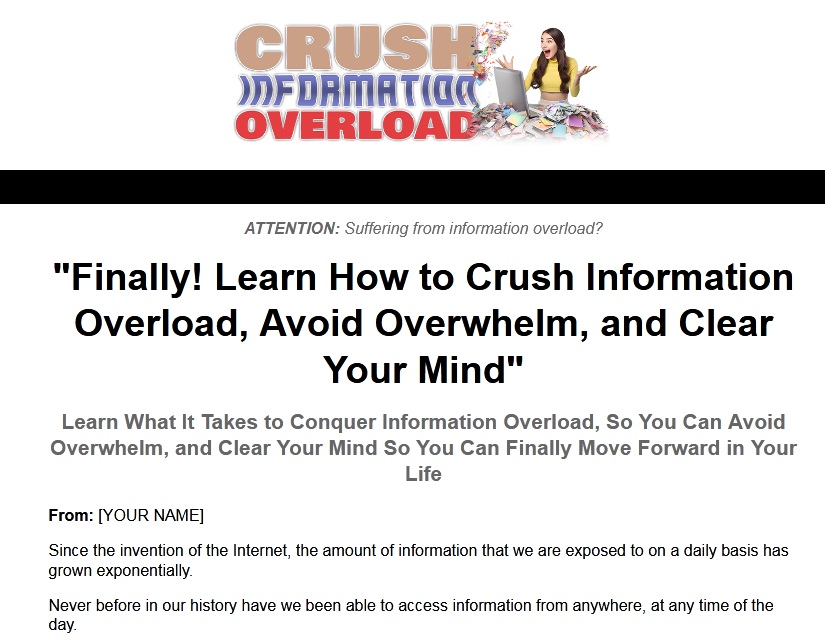Salespage Snapshot

Table of Contents
Introduction ………… 6
Chapter 1 – What is Information Overload ……………………………………………….. 8
The Start of Information Overload ………… 10
The Onslaught of Information …………………… 12
Chapter 2 – The Mind Under Siege …….. 15
Understanding the Enemy …………………………… 16
Social Media’s Role in Information Overload …………………………………………. 17
Enter Social Media …………………………………………….. 18
A Flood of Information …………………………………….. 20
Chapter 3 – Understanding the Limits of Your Working
Memory ………………… 22
What Information Overload Does to the Brain ………………………………………. 24
The Limits of Working Memory ……………….. 25
Nobody is Immune from Information Overload …………………………………….. 27
Chapter 4 – Seeing Information as a Commodity ………………………….. 28
The Information Superhighway ……………….. 30
The Age of Conceptualization ………………….. 31
Chapter 5 – Overcoming Challenges in an Information-Driven World ……………………… 36
Get Everything Done ………………………………………… 37
Laser-like Focus …………………………………………………… 39
Chapter 6 – Limiting Decisions ……………… 43
How to Reduce Decisions ……………………………. 44
Limiting Your Clothing …………………………………….. 45
Limiting Your Food Choices ……………………….. 46
Automate Your Shopping ……………………………… 46
Scheduling Your Evenings ………………………….. 47
Chapter 7 – Organizing Your Home …… 48
Get Ruthless …. 52
Creating Designated Rooms ……………………… 53
Keeping Things Clean …………………………………….. 54
Getting Organized ………………………………………………. 54
Chapter 8 – Organizing Your Social Lives …………………………………………….. 57
Organizing Our Social World …………………….. 59
Prioritize ……………. 61
Get Rid of Frenemies ………………………………………. 62
Limiting Facebook ………………………………………………. 62
Chapter 9 – Organizing Your Time ……… 65
Recognize Your Limits ……………………………………. 65
Make Time to Recover ……………………………………. 66
Timing Your Tasks ……………………………………………… 67
Multitasking ……. 68
Closing Open Loops …………………………………………. 69
Chapter 10 – Organizing Your Professional Life …………………………….. 71
Becoming More Productive at Work ……. 72
Removing Distractions ……………………………………. 73
Reducing Communication Overhead …. 74
Conclusion ………. 76
Sample Content Preview
Information overload is the enemy that is silently creeping up on us daily. It is changing our lives in a subtle yet dramatic way. We’ve gradually moved from a quiet simplistic world to one that is dominated by information. However, we’ve barely acknowledged this change. By examining our environment and understanding the limitations on our internal memory, we can begin to form a foundation of understanding and overcome information overload.
You have to come to understand the limitations of your capabilities and establish the correct fundamental skills and techniques to overcome these limitations successfully. This will help you to reach new levels of productivity in your life. There are those among us that have quietly designed their lives based on their wishes. This creates a sense of control and calmness in today’s chaotic world. Before you can reach this sense of power and calm you have to carefully examine yourself and your limitations.
Social Media’s Role in Information Overload
Social media changed how the world communicates and shares information. Technological breakthroughs have drastically changed the way we obtain our news and information. In fact, 61 percent of people today get most of their news online.
Before the Internet made it possible for anyone to publish information, we relied on professional journalists to research stories and deliver to us what they discovered. Governments and corporations controlled this information, and there was often a delay in sharing information. People huddled around their televisions to be informed of world events. If companies wanted to share news or information about their business, they would have to write a press release and have it distributed to traditional media channels. The media channels would then decide what information they would share with their viewers. Companies who wanted to market to their consumers through traditional media would have to pay for advertising slots and commercial slots, which could cost them millions.
Traditional media, in essence, is very structured and predictable. There are certain rules and guidelines that have to be followed. Despite the idea of “freedom of speech” those working in traditional media are limited in what they can say and do. The information that you get from traditional media is often hierarchical, biased, and non-interactive. If you want to share your opinion about a news item, you have to mail a letter to the editor or producer of the show. Compared to today’s media, the exchange of information and ideas is relatively slow in traditional media.
Enter Social Media
In 2002, two full years before Facebook launched, Jonathan Abram created the online social network site, Friendster, starting the idea of social networking sites and social media. The new social networking sites began a trend of online communication versus face-to-face communication. They allowed you to quickly find out what was going on with family and friends by just logging onto the site. If you have an Internet connection, you have the ability to communicate with anyone in the world quickly and inexpensively. This new ability to exchange information was quick and free-flowing.
After MySpace, Facebook, Twitter, and a variety of other social networking sites were introduced, a whole new world was opened for people around the globe. Add to this the ability to blog and keep online journals; people can more easily share their opinions and ideas freely with people around the world. Since 2002, the Internet has exploded with an abundance of information.
As we began spending more and more time on the Internet interacting with others, governments and corporations started to take notice. Soon, businesses began to realize that for them to keep up with this new era of information and attract new customers, they were going to have to start participating in social media as well. This caused the exchange of information to become even more rampant. Now, instead of being exposed to just news and information, we have corporate communication, promotions, and ads, thrown into the mix.
This has brought about a new way for businesses to market and advertise to consumers. Companies have started to create social media strategies and campaigns to interact with consumers.
Social sites like Twitter are no longer a place for people to share what they were doing that day. With the rise in popularity of social media sites, the idea of quantity over quality has become more prevalent.
To gain more friends on Facebook or get more followers on Twitter, people will say anything and everything, so they can be seen on internet search engines. This has resulted in the quantity of information exchanged becoming more important than the quality of information available. Now, people have to wade through the muddy waters of the Internet to find information that matters the most.
Other Details- 10 Articles (TXT)
- 1 Ebook (PDF), 77 Pages
- 18 Graphic (PNG)
- 1 Salespage (HTML)
- Checklist, Resource Cheat Sheet, Mindmap, Optin Page, Social Media Images, Email Swipes
- Year Released/Circulated: 2023
- File Size: 22,088 KB
License Details:
You may add this product to your PAID membership site
You may giveaway the product as a bonus when people buy through your affiliate link
You may edit the included sales page and opt-in page
No, you may NOT edit the contents of the eBook(s) & videos
No, this product does NOT include private label rights. You are granted Master Resell Rights only
No, you may NOT giveaway the eBook(s) & videos for free. Must be sold for at least $7.00 (videos $17)














